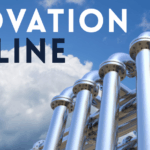[vc_row][vc_column][vc_column_text css=”.vc_custom_1753162117283{padding-top: 30px !important;}”]At Ezassi, we work with global innovation leaders who all are constantly grappling with the same big question: where do innovative ideas come from? While there is no definitive answer that can be applied across the board to all businesses and industries, exploring this question helps to shape strategies and find the right balance between fostering internal innovation and investing in open innovation. Simply pursing this question helps companies remain focused on being adaptive and progressive and avoid becoming static in a dynamic business environment.
Innovation is more than just a buzzword, but it does have the tendency to feel like an abstract concept that lacks concrete boundaries that can be easily defined. Most businesses recognize that innovation is essential to remaining competitive, but aren’t sure where to begin. The feeling that there are too many choices can stall progress, especially when leaders fear making the wrong decision.
Where Do Innovative Ideas Come From?
Is Creativity Dependent on Ideas, or Are Ideas Dependent on Creativity?
It’s a classic chicken-and-egg scenario worthy of spirited debate—are flashes of inspiration crystals formed in the crucible of creativity, or is creativity the spark kindled by new ideas floating by? The truth is, the relationship between the two is far more symbiotic than hierarchical. One can’t thrive long without the other.
Creativity gives rise to ideas, much like Pixar needs storytellers to bring characters to life. Conversely, a fresh idea can ignite inventive thinking—as if Da Vinci, upon seeing a new contraption, suddenly envisioned an invention of his own. So rather than a one-way street, it’s more like a roundabout: each fuels the other, circling endlessly, enabling breakthroughs whether you’re brainstorming in a Silicon Valley garage or at your local café.
Put simply: without creativity, ideas fizzle out unrewarded, and without ideas, creativity has nothing to sink its teeth into. Both are vital cogs in the wheel of innovation—essential for solving problems, delighting clients, and keeping imagination on tap.
Does Overthinking Stall the Flow of Ideas?
If you’ve ever paced your office or scrawled endless notes hoping for a game-changing idea, you know the pitfalls of overanalyzing. Ironically, the harder we push our minds to find a breakthrough, the more likely we are to hit a creative wall. Overthinking or relying solely on critical analysis can actually muffle the spark of inspiration.
Some of the most inventive solutions—think of Google’s infamous “20% time” or the classic napkin-sketch at a Paris café—don’t arrive after hours of exhaustive scrutiny. Instead, great ideas often slip in when the mind relaxes its grip and lets intuition take the driver’s seat. By stepping back and giving our unconscious mind room to work, we allow ideas to surface organically, sometimes surprising us with their clarity and originality.
So, embracing a bit of mental looseness—pausing, listening, and letting thoughts percolate—can be just as crucial for innovation as structured brainstorming sessions or detailed analysis. It’s about finding the right blend: critical thinking to refine, but also the openness to let inspiration sneak up on you.
Does Overthinking Stall the Flow of Ideas?
If you’ve ever paced your office or scrawled endless notes hoping for a game-changing idea, you know the pitfalls of overanalyzing. Ironically, the harder we push our minds to find a breakthrough, the more likely we are to hit a creative wall. Overthinking or relying solely on critical analysis can actually muffle the spark of inspiration.
Some of the most inventive solutions—think of Google’s infamous “20% time” or the classic napkin-sketch at a Paris café—don’t arrive after hours of exhaustive scrutiny. Instead, great ideas often slip in when the mind relaxes its grip and lets intuition take the driver’s seat. By stepping back and giving our unconscious mind room to work, we allow ideas to surface organically, sometimes surprising us with their clarity and originality.
So, embracing a bit of mental looseness—pausing, listening, and letting thoughts percolate—can be just as crucial for innovation as structured brainstorming sessions or detailed analysis. It’s about finding the right blend: critical thinking to refine, but also the openness to let inspiration sneak up on you.
Why Is Receptivity Important in the Creative Process?
If creativity and ideas are partners in an endless loop, then receptivity is the secret handshake that lets them in the door. Many of us grow up trained to analyze, calculate, and out-think our challenges—think of all the times you’ve been encouraged to “brainstorm harder” or “think outside the box.” But, as any seasoned innovator will tell you, the best ideas often don’t announce themselves through brute cognitive force. More often, they arrive during a quiet moment—on a walk, in the shower, or mid-conversation—when your mind is relaxed rather than revved up.
Receptivity is key because it unlocks those unexpected connections and flashes of inspiration that deliberate thinking can miss. It’s less about wrangling answers and more about creating a mental wide-open field—where intuition, memory, and even a bit of serendipity can spark something new. When you allow yourself to be receptive, you shift from pushing out ideas to tuning in, much like an artist waiting for a brushstroke of inspiration or a jazz musician leaving space for improvisation.
In short, cultivating a receptive mindset allows fresh ideas to percolate and rise to the surface. It’s about listening—to yourself, to your team, to the subtle cues in your environment. Receptivity makes it possible to catch those elusive lightbulb moments, making sure innovation keeps humming along, fueled as much by what you notice as by what you already know.
Creativity: Problem to Solve or Message to Receive?
So, what’s the real difference between treating creativity as a problem to crack versus welcoming it as a message to receive? Think of it this way: when we view creativity as a problem, we often fall into analytical mode—dissecting, troubleshooting, and engineering our way toward a breakthrough, much like how an engineer might wrangle a stubborn algorithm or a design team iterates through hundreds of prototypes.
On the flip side, seeing creativity as a message to receive is a bit like tuning an old radio—sometimes inspiration arrives on a wave of quiet insight when we simply pay attention. Rather than wrestling ideas into submission, we listen, absorb, and let them bubble up from observation, intuition, or even quiet moments walking the dog.
Both approaches can spark innovation. Sometimes you need the rigor of structured brainstorming sessions—whiteboards scribbled with wild diagrams and post-it notes at every turn. Other times, creativity flows when you step back, let your mind wander, and allow those half-formed notions to surface naturally.
In short, innovation often emerges from toggling between the discipline of problem-solving and the openness of receiving insights. Striking that balance can make all the difference in how ideas take shape and how your team unlocks its next big breakthrough.
Striking the Balance: Being and Doing in Creative Practice
No matter where you are in your creative journey—tacking sticky notes to a whiteboard, sketching in a Moleskine at the park, or jotting down epiphanies on the back of a coffee receipt—the tug-of-war between “being” and “doing” is real. It’s easy to lean into relentless action: crossing tasks off Trello boards, tackling deadlines, and chasing productivity. Yet, creativity demands something more: moments of stillness, reflection, and a willingness to simply be.
So how do you hit that sweet spot between thoughtful presence and productive effort? Here are a few strategies that our innovation-minded community swears by:
- Embrace Mindful Pauses: Regularly carve out quiet pockets in your day—whether it’s a morning meditation, a silent stroll, or simply staring out the window. Let your brain breathe. Like Google’s famed “20% time,” these open-ended moments invite unlikely ideas to surface.
- Alternate Modes: Structure your schedule to include both deep-dive work sessions (when you roll up your sleeves and get hands-on) and space for open-ended exploration (where you allow yourself to play with ideas, doodle, or daydream without immediate expectations).
- Treat Roadblocks as Signals: Hitting a creative wall? Instead of grinding harder, treat it as an invitation to step back. Often, inspiration walks in when you stop hammering at the door.
- Ritualize Transition: Develop simple rituals (closing your laptop, making tea, switching locations) to signal shifts between being and doing. Even top innovators from IDEO to Apple swear by these micro-habits to keep their minds limber.
- Reflect and Iterate: Spend a few minutes each week reviewing what energized you most—was it planning, experimenting, or simply letting ideas marinate? Use those insights to tune your own rhythm of action and reflection.
The most successful creative practitioners—whether they’re coding in a bustling incubator or sketching under a maple tree—learn to honor both the quiet inner work and the exhilarating bursts of making. Finding your personal cadence is key to not just hatching ideas, but nurturing them to life.
What Role Does Listening Play in Creativity?
Listening is often the unsung hero of the creative process. It goes beyond simply hearing words—genuine listening means tuning in to subtle cues, random insights, and quiet hunches that might otherwise get drowned out in the usual bustle of daily tasks. When we shift gears from constant doing to thoughtful observing, our minds become less like an over-caffeinated squirrel and more like a finely tuned antenna—catching unexpected signals from our environments, our colleagues, and even our own intuition.
Think of it as quieting the mental noise so new ideas can bubble to the surface. Whether you’re soaking up feedback in a brainstorming session, picking up on unspoken customer needs, or paying keen attention to that nagging question you just can’t shake, true listening creates the space for strikes of insight. It’s about letting go of over-analysis and embracing the art of being present—so those “aha!” moments aren’t forced, but received.
Listening, then, is not a passive act. It primes our creativity, making it far more likely that we’ll spot connections others miss and discover inspiration in places we least expect.
Why Set Aside Ego in the Early Stages of Creativity?
When it comes to nurturing innovative ideas, the ego is a bit like an overzealous editor redlining a barely drafted script—it means well, but it’s a little too eager at the wrong moment. In those early, delicate stages of brainstorming, it’s crucial to quiet that inner critic. Why? Because the ego tends to interrupt with judgment and skepticism just when your ideas are at their most vulnerable.
Allowing yourself—and your team—the freedom to dream without fear of criticism creates fertile ground for bold, original thinking to take root. If you’ve ever watched an improv show or participated in a Pixar-style storyboarding session, you know the emphasis is on saying “yes, and…” rather than “no, but…” Ideas need encouragement and patience before they’re subjected to rigorous review.
There will be time later for evaluating and refining. But in the beginning, the name of the game is exploration, not evaluation. Stepping aside from ego-driven judgment gives you and your colleagues license to explore unexpected possibilities—sometimes the wildest notion is what eventually becomes the big breakthrough.
What Is the Original Meaning of “Inspiration”?
Let’s peel back the layers for a moment and look at where the word “inspiration” actually comes from. Long before we started using it to describe brilliant brainstorming sessions or flashes of genius in an Apple keynote, “inspiration” had a more mystical flavor. At its root, it literally meant “to breathe in”—and it carried the sense that a person was filled or imbued with a guiding spirit or divine influence. (The Latin root, spirare, meaning “to breathe,” also gave rise to the words “spirit” and “aspire.”)
In other words, inspiration was thought to be something almost magical, as if a creative wind (perhaps from the same repertoire as The Muse Company, if you will) swept through, energizing someone with new ideas. That original sense still lingers today—whether we recognize it as a sudden spark during a quiet walk or a eureka moment scribbled on the nearest Starbucks napkin.
The Subtle Art of Intuition and Creativity
Now, let’s talk about intuition—the unsung hero in the innovation playbook. While creativity often gets the spotlight, intuition quietly shapes the process behind the scenes, acting as that gentle nudge or whisper that guides inventors, writers, and entrepreneurs toward new possibilities.
Unlike logical reasoning, which demands hard evidence and step-by-step analysis, intuition slips in when you’re least expecting it. Think of it as your internal Google search, delivering results without you consciously typing in a query. Many innovators, from Einstein brainstorming thought experiments to a chef improvising in the kitchen, credit their best breakthroughs to flashes of intuitive insight rather than deliberate calculation.
But here’s where it gets interesting: intuition and creativity aren’t rivals—they’re partners in crime. Intuition feeds creativity those first sparks of inspiration. It’s the soft voice suggesting a new angle when your mind is stuck, or the feeling that a novel idea just “feels right” before you have the data to back it up. Creativity, for its part, transforms that gut feeling into real-world results, whether it’s a solution to a manufacturing bottleneck or the seed of a new marketing campaign.
So how do you leverage this duo?
- Tune out the noise: Sometimes that next big idea emerges when you step away from the whiteboard, take a walk, or let your mind wander in the shower.
- Hold judgment: Allow oddball notions—even the ones your inner critic tries to shoot down—to breathe before evaluating them.
- Review and refine: Once intuition hands you a creative spark, let your analytical side step in to polish and implement.
In short, intuition opens the door, creativity decorates the room. Together, they help teams break away from the “way we’ve always done it” and discover what’s possible in today’s fast-paced landscape.
What Are the Psychological Perspectives on the Origin of Ideas?
From a psychologist’s lens, the birthplace of ideas is an intricate dance within our minds. It’s not just neurons firing in the brain—though that’s the hardware behind the magic—but also the invisible processes of thought, memory, and emotion blending together. Much of our creative spark bubbles up from the unconscious, that mysterious backstage where novel connections are made and creative leaps occur.
Interestingly, psychologists also highlight the social nature of inspiration. Our creativity doesn’t thrive in a vacuum; it multiplies when we tap into the thoughts, perspectives, and imaginative leaps of others. In other words, the more we’re exposed to creative minds—think Leonardo da Vinci sketching with inspiration from his Renaissance cohorts, or designers riffing off each other at IDEO—the more fertile our own ideas become.
Why Is It Important to Give Ideas Room to Breathe?
If you’ve ever watched a master chef at work (or perhaps fumbled through a new recipe yourself), you know that the best flavors emerge when each ingredient has time to simmer and meld. The same holds true for ideas. In the earliest stages, a concept is fragile—more soufflé than steel trap. Rushing to judge or dissect it too quickly is like poking soufflés before they’ve had a chance to rise; all you’re left with is a sunken, deflated mess.
Creating space for unfiltered brainstorming allows novel connections to take shape, free from the constricting grip of inner critics or the relentless editor in our heads. Think about artists who sketch loosely or writers who churn out a rough first draft: pressing “pause” on critique lets imagination stretch its legs and wander into unexpected territory.
By withholding judgment early on, you:
- Encourage exploration and originality over “safe” or conventional thinking.
- Prevent self-censorship, allowing more daring or unusual concepts to surface.
- Foster a more psychologically safe space, whether alone or in a team, where no one fears their ideas will be shot down mid-flight.
The world’s most inventive solutions—Post-It Notes, penicillin, even the humble Slinky—were all given time to grow without being nipped in the bud. By providing this open runway, you invite more possibilities to take flight before refining or critiquing comes into play.
How Does Modern Society Shape Our Approach to Thinking and Creativity?
From a young age, society encourages us to view the world through the lens of logic and reason—Descartes’ “I think, therefore I am” seems to underpin everything from grade school math class to boardroom strategy sessions. We’re often taught to trust our analytical minds, to figure things out using clear steps and rational arguments.
Yet, there’s a limit to what deliberate thinking alone can offer. The act of creating—whether it’s composing a symphony or reimagining a business process—often demands something beyond careful calculation. To tap into true creative insight, we need to loosen our grip on logical problem-solving and embrace a more open, intuitive state. Think of it as shifting gears from constant analysis to a kind of quiet listening, where the answers aren’t forced, but discovered, sometimes when we least expect them. This delicate balance—honoring both intellect and intuition—is at the heart of how today’s innovators and artists turn inspiration into tangible results.
How Mindfulness and Creative Rituals Boost the Creative Process
If creativity is the engine that drives innovation, mindfulness and daily rituals are the premium fuel that keep it humming at full speed. While brainstorming sessions and whiteboard marathons have their place, science—and the experience of countless creators, from Maya Angelou to Steve Jobs—suggests there’s real power in slowing down and cultivating mindful habits.
Mindfulness isn’t just for yogis or meditation retreats in Sedona. At its heart, it’s about nurturing awareness of the present moment—taking time to check in with your thoughts, noticing where inspiration bubbles up, and being open to the unexpected twist or spark. Many breakthrough ideas have surfaced not during frantic scribbling, but in the quiet between the notes: a solo walk, the gentle hum of morning coffee rituals, or simply allowing the imagination to drift.
Adopting creative rituals further supports this process. Think Hemingway composing at sunrise, or JK Rowling’s fabled writing nooks. Simple, repeatable actions—like daily journaling, mood-boarding before design work, or setting aside 10 minutes to “brain dump” ideas—coax the mind into a state of readiness. Over time, these rituals condition your brain to flip the switch from scattered to focused, from blocked to flowing.
Here’s how mindfulness and ritual can elevate your creative efforts:
- Promotes Focus: Regular mindfulness practices, like conscious breathing or guided meditations, help quiet internal chatter, freeing up mental space for problem-solving and idea generation.
- Breaks Creative Blocks: Observing thoughts without judgment allows you to see obstacles as transient, rather than insurmountable, making it easier to move past “blank page syndrome.”
- Sparks Flow State: Ritualized practice signals to your brain that it’s time to create, increasing your chances of entering that coveted “flow” where ideas seem to pour out effortlessly.
- Facilitates New Connections: Mindfulness fosters openness, making it more likely you’ll spot surprising links or novel solutions—like noticing a design pattern in nature that informs your next prototype.
- Builds Lasting Habits: Simple daily actions, whether it’s a 5-minute sketch or jotting ideas before bed, reinforce creativity as a part of your routine, not just a lucky accident.
In short, combining mindfulness with creative ritual is less about waiting for inspiration to strike, and more about making a habit of being ready when it does—much like a jazz musician, always tuning their instrument and listening for the unexpected note.
By weaving mindfulness and creative routines into your day, you not only boost the odds of lightning striking but ensure you’re holding the right antenna when it does.
How Can You Attune Your Awareness to Intuition?
If you’ve ever felt like your best ideas arrive out of nowhere—perhaps during a shower, a long walk, or as you’re drifting off to sleep—that’s intuition quietly at work. The trick is learning to notice and nurture those subtle nudges before your inner critic swoops in with a red pen.
To better tune into your intuitive insights, consider these strategies:
- Create mental quiet: Give your mind regular pauses. Whether it’s a stroll in Central Park or time at your favorite coffee shop, space away from information overload gives intuition room to surface.
- Suspend judgment (for now): In the earliest stages of idea generation, resist the urge to judge or analyze. There’s time for the “Is this practical?” question later—think of it like jotting down wild concepts on a napkin before the real vetting begins.
- Practice patience: Much like cultivating a bonsai tree or brewing a perfect cup of coffee, intuitive flashes can’t be rushed. Sit with your thoughts, let them swirl, and trust that connections will emerge naturally.
By temporarily setting aside the inner editor—much as Pixar animators might let a story meander before tightening the plot—you allow your subconscious mind to work its magic. When you create space to listen, you find that intuition contributes meaningfully, weaving together fragments of knowledge and experience to deliver surprisingly fresh perspectives.
Now that we’ve explored the fertile soil where ideas first sprout, what about the sources that feed innovation in the business world?
The Main Sources of Innovation
Fortunately, studies show that innovative ideas tend to come from a few main sources, which can provide valuable guidelines on where to invest time and energy. Ultimately, innovation comes from a combination of internal and external sources. According to Incremental Innovation, here are the most important sources of innovation:

- Customers (accounts for 50% of all innovative ideas)
- Marketing and sales department
- Employees
- Competitors
- Suppliers
- Firm leaders
As the end user, it makes sense that customers would serve as an important source of feedback that leads to innovative solutions that drive transformational changes as opposed to incremental. This means that businesses need to actively seek out, analyze and value customer feedback.
Understanding Diffusion: How Ideas Move Across Cultures
When thinking about where innovation really begins, it’s helpful to consider not just where ideas originate, but also how they travel. This is where the concept of diffusion comes into play. In the world of anthropology, diffusion describes the process by which new ideas, practices, or technologies spread from one group or culture to another.
Through diffusion, a spark of innovation in one corner of the world—say, a new payment technology popularized in Japan—can inspire changes across industries in entirely different regions. This process doesn’t happen in a vacuum: our environments, communities, and interactions all influence and accelerate the sharing of creative solutions.
Countries, companies, and teams benefit by remaining open to outside influences and learning from best practices elsewhere. Cultural festivals, international business partnerships, and even global conferences are arenas where the seeds of new ideas are planted and exchanged. By recognizing and encouraging this flow, organizations increase their ability to adapt and thrive, transforming unique ideas from distant origins into homegrown innovations.
The Anthropological Perspective: How Culture Shapes Innovation
While data and feedback provide a clear roadmap for sourcing ideas, anthropology offers another layer by examining how our environments and communities influence the birth and spread of innovation. Anthropologists often observe that ideas don’t appear in a vacuum—they’re shaped by the interactions, rituals, and beliefs within a community.
Innovation frequently emerges not from solitary genius, but from groups collaborating, sharing, and refining concepts together. This collective approach is what makes some ideas truly transformative, as social dynamics encourage adaptation and reinvention.
A central theme in anthropology is the diffusion of ideas—how innovative concepts migrate from one culture to another, adapting along the way. This transfer is just as important as the initial spark of creativity, highlighting the importance of diverse teams, open communication, and environments where cross-pollination of ideas is possible.
Understanding innovation through the lens of anthropology underscores that both the generation and the journey of an idea deserve attention. By fostering a culture where sharing and adapting ideas is encouraged, businesses can unlock new avenues for progress and creativity.
Philosophers’ Take on the Source of Ideas
Interestingly, philosophers have long pondered the origins of ideas, offering perspectives that add depth to our understanding. Thinkers like Descartes and Locke approached ideas as something deeply rooted in human nature—almost as if they emerged spontaneously from within. To them, ideas weren’t simply reactions to the physical world, but the mind’s unique interpretations and representations of the things we encounter.
In this view, having ideas is an essential part of being human—automatic, reflexive, and sometimes sparked by the simplest interactions with people or objects. The philosophical stance suggests that our capacity for ideas isn’t just a learned behavior, but an innate part of the way we process and engage with the world. While modern innovation looks to customers, teams, and industry trends, these classic perspectives remind us that the spark for new ideas often starts with something less tangible: the way we think and perceive.
Are Humans Uniquely Capable of Having Ideas?
When it comes to the origins of ideas, philosophers such as Descartes and Locke have long argued that the ability to generate ideas is a uniquely human trait. Their theories suggest that the process of forming ideas is closely tied to human consciousness and the mind. According to this school of thought, ideas arise as mental representations—shaped by our perceptions, experiences, and interactions with the world around us.
In this view, humans aren’t just passive recipients of information; rather, we actively create new concepts and solutions. These ideas may seem spontaneous at times—almost surfacing out of thin air as we go about our daily lives. Yet, it’s this reflexive and deeply internal process that distinguishes humans from other species, at least from a classical philosophical standpoint.
Ultimately, these philosophical perspectives reinforce the belief that fostering environments where people are encouraged to reflect and explore is crucial for nurturing innovation. This emphasis on human ingenuity ties directly back to the importance of valuing feedback from those closest to the work—your employees and internal teams.
Don’t Underestimate Existing Resources
The fact that internal employees also represent a significant source of innovative ideas highlights the importance of tapping into existing resources and creating an environment where internal employees are able to explore new ideas while also spending time on daily tasks. The innovation prescription for most companies includes a combination of internal and external input. Finding the right balance is the true challenge, but recognizing that they are both important is the best first step.
Our clients recognize the importance of not just talking about innovation, but actively working to create a culture of innovation that includes targeted programs that reach throughout every level of the organization. While external collaborators can be valuable resources, time and again, we have seen innovative ideas come from employees who may be underutilized or discouraged from sharing ideas due to the company culture. True innovation comes from being open to a wide variety of sources, including those that may already exist, but simply aren’t being used to their full potential.[/vc_column_text][vc_column_text css=”.vc_custom_1750769594122{padding-top: 20px !important;}”]
What to Do When Creative Roadblocks Strike
If you find yourself struggling to come up with fresh ideas, you’re not alone—it happens to even the most seasoned innovators. One effective strategy is to look beyond your immediate circle and invite perspectives from outside your organization. External input, whether from industry experts, thought leaders, or even unconventional sources like customers or academia, can spark new thinking and help you break through creative barriers.
Here are a few practical suggestions:[/vc_column_text][vc_row_inner css=”.vc_custom_1750767315093{padding-top: 20px !important;padding-bottom: 20px !important;}”][vc_column_inner width=”1/3″][vc_column_text]
Engage in Cross-Industry Conversations
Attend conferences, webinars, or networking events in adjacent fields to see how others tackle similar challenges.
[/vc_column_text][/vc_column_inner][vc_column_inner width=”1/3″][vc_column_text]
Leverage Crowdsourcing
Platforms like Innocentive and IdeaScale let you gather insights from a global community, expanding your pool of inspiration.[/vc_column_text][/vc_column_inner][vc_column_inner width=”1/3″][vc_column_text]
Consult Strategic Partners
Reach out to suppliers, consultants, or even friendly competitors for a quick brainstorming session or an informal discussion.[/vc_column_text][/vc_column_inner][/vc_row_inner][vc_column_text]Remember, stepping outside your routine and connecting with different perspectives just might lead to your next breakthrough. Sometimes, all it takes is a conversation to unlock a whole new direction.[/vc_column_text][vc_row_inner css=”.vc_custom_1750776040701{padding-top: 20px !important;}”][vc_column_inner][vc_column_text]
The Role of Culture and Environment in Shaping Ideas
Another often-overlooked driver of innovation lies in the influence of our environment and the culture that surrounds us. Just as customer feedback and employee input are invaluable, the context in which we operate acts as fertile ground for new ideas to take root and flourish.
Cultures that encourage open dialogue, curiosity, and knowledge-sharing tend to nurture greater innovation. When teams and departments collaborate rather than compete, and when diverse perspectives are welcomed, unique solutions emerge—often in ways that individual silos simply can’t replicate. This communal mindset doesn’t just foster creativity; it also speeds up how quickly ideas are refined and adopted.
Historical examples abound: consider how concepts like sushi migrated from Japan to become a global phenomenon, or how Silicon Valley’s culture of collaboration and risk-taking turned a pocket of California into the world’s tech epicenter. These cases show that as ideas travel from one community or culture to another, they’re reshaped and improved, gaining new value through exchange.
In short, our surroundings—both physical and social—can act as powerful catalysts, providing access to new perspectives and amplifying the spread of breakthrough innovations. For organizations looking to thrive, cultivating a culture that values shared exploration can accelerate the journey from idea spark to industry shift.[/vc_column_text][/vc_column_inner][/vc_row_inner][/vc_column][/vc_row][vc_row][vc_column][vc_empty_space][vc_column_text]
Let’s Talk
[/vc_column_text][vc_empty_space][vc_raw_html]JTNDJTIxLS0lNUJpZiUyMGx0ZSUyMElFJTIwOCU1RCUzRSUwQSUzQ3NjcmlwdCUyMGNoYXJzZXQlM0QlMjJ1dGYtOCUyMiUyMHR5cGUlM0QlMjJ0ZXh0JTJGamF2YXNjcmlwdCUyMiUyMHNyYyUzRCUyMiUyRiUyRmpzLmhzZm9ybXMubmV0JTJGZm9ybXMlMkZ2Mi1sZWdhY3kuanMlMjIlM0UlM0MlMkZzY3JpcHQlM0UlMEElM0MlMjElNUJlbmRpZiU1RC0tJTNFJTBBJTNDc2NyaXB0JTIwY2hhcnNldCUzRCUyMnV0Zi04JTIyJTIwdHlwZSUzRCUyMnRleHQlMkZqYXZhc2NyaXB0JTIyJTIwc3JjJTNEJTIyJTJGJTJGanMuaHNmb3Jtcy5uZXQlMkZmb3JtcyUyRnYyLmpzJTIyJTNFJTNDJTJGc2NyaXB0JTNFJTBBJTNDc2NyaXB0JTNFJTBBJTIwJTIwaGJzcHQuZm9ybXMuY3JlYXRlJTI4JTdCJTBBJTA5cmVnaW9uJTNBJTIwJTIybmExJTIyJTJDJTBBJTA5cG9ydGFsSWQlM0ElMjAlMjI0MjY3NDElMjIlMkMlMEElMDlmb3JtSWQlM0ElMjAlMjJkMzlmZjZkNC04MTNkLTRjMjYtYjdhOS02YmNjMjAzY2UzYTUlMjIlMEElN0QlMjklM0IlMEElM0MlMkZzY3JpcHQlM0U=[/vc_raw_html][/vc_column][/vc_row]






